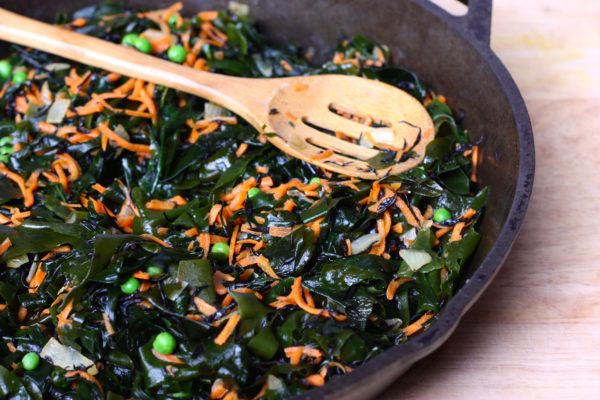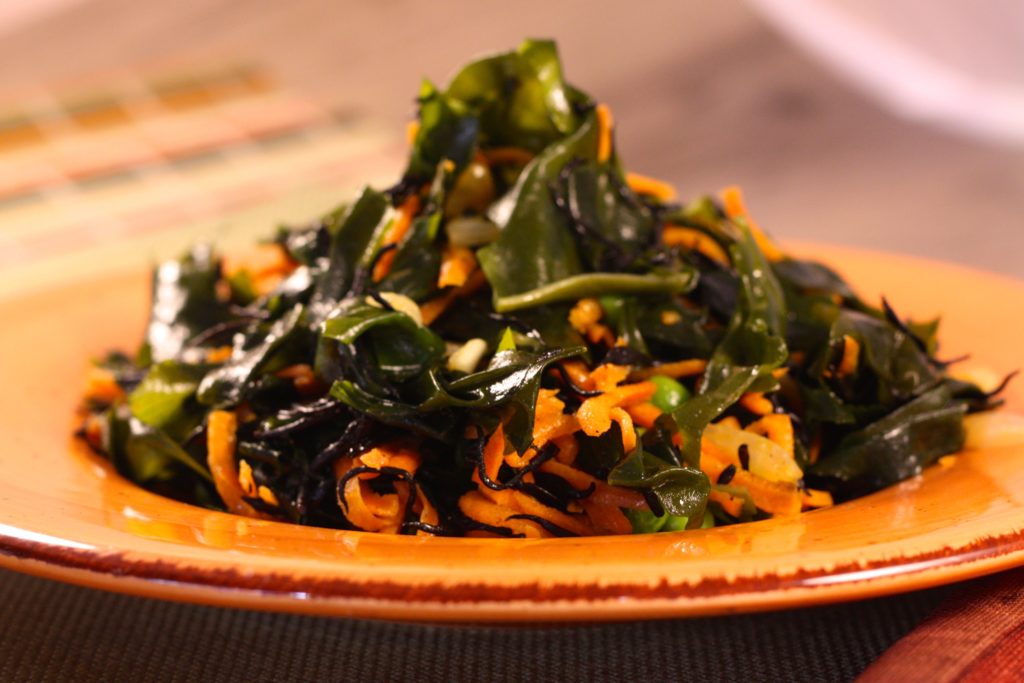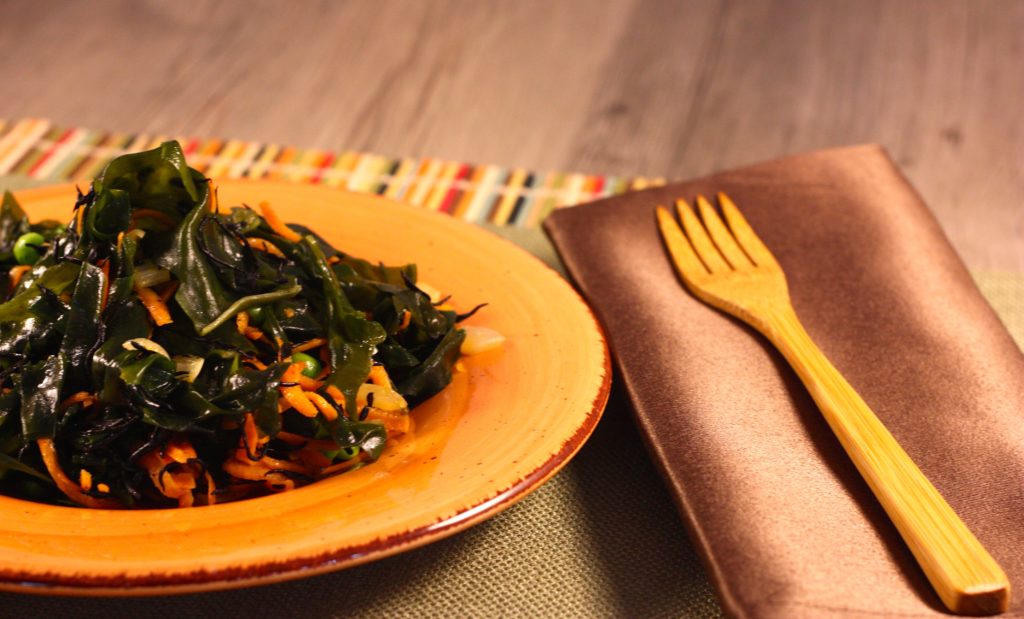
This warm seaweed dish started out as my own quirky exploration into the world of making seaweed taste delicious. I was surprised when it caught on like wildfire amongst my friends and clients. Before I knew it, seaweed-phobic friends were scrambling it with their morning eggs and hiring me to make it in large quantities. It is a super nutritious vegetable side that goes great with any meal of the day. It combines your choice of seaweed with caramelized onions, grated carrots and green peas cooked in butter from grass-fed cows, ghee or coconut oil. We should all be eating seaweed for optimal health, and this is a delicious way to include it!
Culinary lesson from sea turtles
Occasionally, as I’m swimming in our tropical turquoise waters, weaving around the massive coral heads, I’ll run into one of my favorite sea creatures. The Hawaiians call them Honu, but you know them as sea turtles. These chilled out animals glide effortlessly through the water with a presence that exudes ancient wisdom.
Every time I come upon a sea turtle feeding on the many types of seaweed growing around the islands, I feel inspired to do the same. I could probably just swim over and start munching on the swaying brown, green and purple fronds. However, selecting and preparing wild foods requires knowledge that must be passed along from personal experience, so don’t just run out and eat anything under the sea because some species may be toxic.
![By P.Lindgren (Own work) [CC BY-SA 3.0 (http://creativecommons.org/licenses/by-sa/3.0)], via Wikimedia Commons](http://olaloawellness.com/site/wp-content/uploads/2015/07/Wiki-Sea-Turtle.jpg)
That said, many of the wild seaweeds here are indeed edible to humans and have been staples in the traditional Hawaiian diet for many centuries. Inspired by the Honu’s underwater salad, I head back home to prepare one of my favorite sea vegetable recipes.

Hold up! Why should I eat seaweed?
Here’s the short answer: It will help you look and feel fabulous.
Here’s the not so long answer…
Energy, strength, stamina…
Seaweed, in general, is considered to be among the most nutrient dense of all vegetables, which gives you energy and makes it a great recovery food to replenish the body after a hard workout. I consider it one of the keys to my strength and stamina in the water. Forget sports drinks, bars and goos. The minerals in seaweed are the best kind of electrolytes.
Iodine = thyroid support, radiation detox and much more…
Most seaweed has a nice amount of iodine that your thyroid needs and should certainly appreciate, especially if you are hypothyroid (that’s too low), or even on the lower side of normal. If you are on the hyperthyroid (high) side of the spectrum, you might want to limit your intake a bit. Listen to your body and see how you feel. Your thyroid is directly linked to your energy levels and many crucial body functions, so be loving to it and it will love you.
Iodine also plays a role in seaweed’s protective properties, and is often used by holistic practitioners to clear the damage of radiation (or prevent it in the first place). Taking too much isolated, concentrated iodine without supervision can be a little risky to the thyroid, so enjoy it in this whole food matrix evolved in the ancient wisdom of mother earth’s oceans.
OK, I’ll try it. Where do I start?
Seaweed is technically an algae and the huge variety can make it a daunting field to explore. Here I focus on three of my favorites, wakame, hijiki and arame.
- Wakame is green with a mild flavor and soft texture, making it great for seaweed beginners. It is high in omega-3 fatty acids, calcium, iodine, thiamine, niacin and the fat burning compound fucoxanthin.
- Hijiki has been prized by the Japanese for centuries. They credit it as a natural health and beauty aid that gives lustrous thick hair.
- Arame is a brown algae packed with minerals including calcium, iodine, iron and magnesium. It’s also high in vitamin A and has a mild, almost sweet flavor. They are all considered immune boosting super foods.
Wakame, hijiki and arame are usually sold pre-cut, pre-cooked and dried. All you have to do is soak them in water for 5 minutes in order to rehydrate them. Dried seaweed is a great food for long term storage and disaster preparedness (if you’re into that sort of thing), because of its shelf stability, light weight and nutrient density. Once rehydrated, it’s just like having fresh vegetables right from the sea. Look for wakame and hijiki in the Asian aisle of your favorite grocery store, or if you want to pay more get it from your local health food stores. Arame is usually only found at health food stores.
If you are new to seaweed and feel any trepidation, I suggest starting with just wakame in this recipe. Once you fall in love with it, try adding arame, which is milder in flavor than hijiki. I actually love the taste of hijiki, but it is a little stronger than the other two, so try it when you are feeling adventurous or really hungry.
So now you know how easy it is to make seaweed. Try it out and let us know what you think.


Ingredients
Method
- Start by soaking the seaweed in a medium sized bowl with about 4 cups of water.
- Sauté the onions in butter on medium high heat until they are soft and just starting to caramelize.
- Then add the grated carrots, peas and sea salt, cooking until soft, about 5 minutes.
- While the vegetables are cooking, drain the water from the seaweed using a colander or mesh strainer. (Reserve the seaweed soak water for your garden or potted plants. They love the minerals!)
- When the vegetables finish sautéing, add the rehydrated, drained seaweed. Mix well and continue to cook for a few more minutes. Serve warm or chilled.
